Excess Mortality in Ireland in 2020
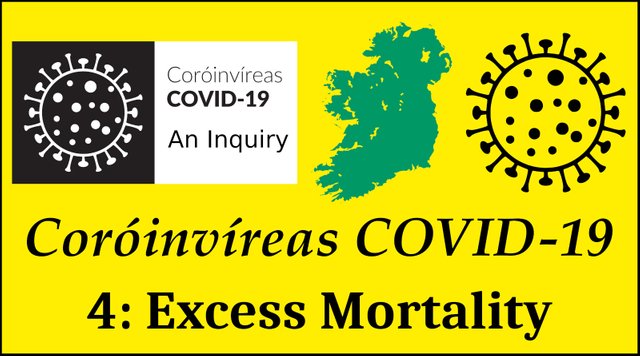
With the preliminaries out of the way, we are now ready to address the question of excess mortality in Ireland during the Covid-19 pandemic. For this part of our inquiry we will be relying on data extracted by Kieran Morrissey from RIP.ie. As we saw in the second article in this series, this website is now widely accepted as a reliable indicator of all-cause mortality. We quoted Tony Holohan, the chairman of NPHET (the Republic’s National Public Health Emergency Team) to the effect that RIP.ie captures in excess of 98% of all deaths (thejournal.ie, 15 June 2020).
Northern Ireland, however, has no corresponding source. For excess mortality in the North, we have no choice but to rely on the Registrar General’s interim quarterly reports, which provide provisional statistics. The finalized data for 2020 will be published in the Registrar General Annual Report, which is unlikely to come out before December 2021. The annual reports for earlier years are available online.
The RIP.ie Data
In his online paper, Ireland: Study of COVID-19 Deaths, Kieran Morrissey first tabulates the raw data for the years 2014-2020 and the first three months of 2021. Table 1 presents the data from RIP.ie, with overseas and duplicate death notices removed. Table 2 presents the current tally of deaths registered with the General Register Office. The figures in Table 2, then, are subject to amendment:
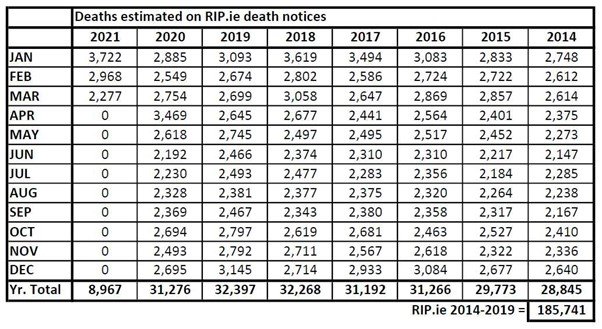
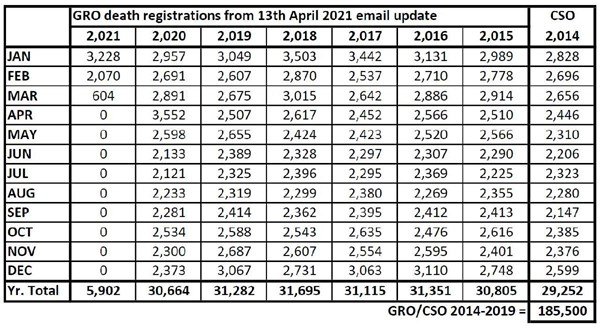
As can be seen, 2020, the year of the Covid-19 pandemic, does not stand out from previous years. The current population growth rate for the Republic is estimated to be 0.97% (The World Factbook), so we expect the annual number of deaths to be increasing on average. But according to the RIP.ie data, fewer people died in 2020 than in 2019 or 2018. This is also the case even if we assume that the RIP.ie figures are only 98% of the true figures. And the GRO figures are even more damning: 2020 had fewer deaths than every year in the table except 2014. On the face of it, these tables do not suggest that there was a pandemic in the Republic of Ireland in 2020:
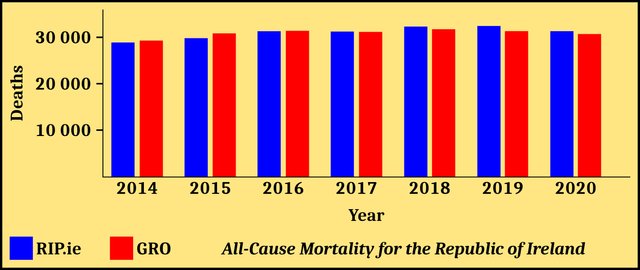
Northern Ireland
The North provides an interesting comparison with the Republic. The all-cause mortality statistics for 1887-2019 can be found on the NISRA website. For 2020, we have the four interim quarterly reports, which are available here. The latter are subject to amendment:
| Year | Mortality |
|---|---|
| 2012 | 14,756 |
| 2013 | 14,968 |
| 2014 | 14,678 |
| 2015 | 15,548 |
| 2016 | 15,430 |
| 2017 | 16,036 |
| 2018 | 15,922 |
| 2019 | 15,758 |
| 2020 | 4,330 + 4,684 + 3,814 + 4,786 = 17,614 |
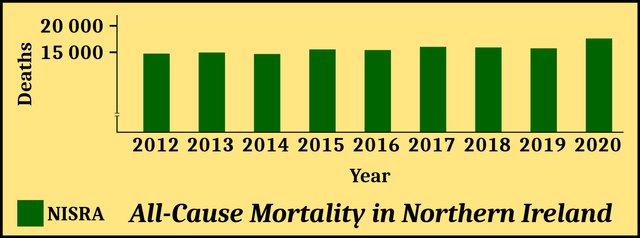
These statistics are in stark contrast to those from the Republic. In 2020, all-cause mortality in Northern Ireland was higher than it was in any year since 1973. Almost two thousand more people died in the province in 2020 than in 2019. On the face of it, this supports the claim that a deadly pandemic was present in 2020.
What are we to make of this striking divergence between the mortality statistics in the two jurisdictions that share the island of Ireland? It would be a strange pathogen that could cause a clear spike of excess mortality in the North while at the same time sparing the Republic. Do viruses respect international boundaries?
Death Rates
As pointed out above, the population of the Republic is growing by about 0.97% per annum. In order to compare the mortality statistics for two or more years, therefore, we ought to take into account the difference in population between those years. One way of doing this is to track the death rate rather than the absolute number of deaths. The crude death rate for a given year is the number of people who died in that year for every 1,000 people in the population:

As Kieran Morrissey expresses it:
... the health of a nation can be quickly assessed by looking at its trend [in] death rates as quoted in deaths per 1,000 of population.
Drawing on the Central Statistics Office’s annual reports, the recently updated GRO data, and the RIP.ie death notices for 2020, Morrissey has calculated the annual death rates for the last nine years:

This table shows that the death rate for 2020 was the lowest since 2012, a clear indication that there was no pandemic the Republic of Ireland in 2020.

Let’s do the same for Northern Ireland. Mid-Year Population Estimates for Northern Ireland are available on the NISRA website (rounded to the nearest 100). The estimate for 2020 will not be released until June 2021, so I have estimated it myself using the protocol described by NISRA here:
| Year | Mid-Year Population | Annual Deaths | Death Rate |
|---|---|---|---|
| 2012 | 1,823,600 | 14,756 | 8.09 |
| 2013 | 1,829,700 | 14,968 | 8.18 |
| 2014 | 1,840,500 | 14,678 | 7.98 |
| 2015 | 1,851,600 | 15,548 | 8.40 |
| 2016 | 1,862,100 | 15,430 | 8.29 |
| 2017 | 1,870,800 | 16,036 | 8.57 |
| 2018 | 1,881,600 | 15,922 | 8.46 |
| 2019 | 1,893,700 | 15,758 | 8.32 |
| 2020 | 1,903,300 | 17,614 | 9.25 |

In Northern Ireland, the death rate for 2020 was 9.25, the highest for several years. According to the website UK Population, the population for the middle of 2020 was 1,905,484. This estimate reduces the death rate, but only slightly, to 9.24.
In the Republic, the crude death rate for 2020 was the lowest since 2012. For the North, it was by far the highest since 2012. Were the measures adopted in the two jurisdictions to control the spread of Covid-19 so divergent that the death rate during the pandemic fell by 1% in one part of the island and rose by 11% in another part? Or is there some other explanation for this disparity? There is a mystery here to be solved, but we need to take a closer look at the two waves of Covid mortality before we can hope to solve it.
Also to be examined is the claim that the lockdowns and other measures taken to control the spread of Covid-19 reduced deaths due to other causes:
Other vested interests claim that the lockdowns have reduced influenza deaths and accidental deaths which compensate for the extra COVID-19 deaths and that this explains why the total or excess deaths are not higher in 2020. (Morrissey)
This is in the stark contrast to the alternative claim: that the lockdowns have wrought a huge death toll of their own, while doing little or nothing to halt the spread of the disease they were meant to contain.
And that’s a good place to stop.
References
- Kieran Morrissey, Ireland: Study of COVID-19 Deaths, Global Research (2021)
- Denis G Rancourt, All-Cause Mortality during COVID-19: No Plague and a Likely Signature of Mass Homicide by Government Response, Research Gate (2020)
Image Credits
- COVID-19 Poster: © 2021 Dublin Region Homeless Executive, Fair Use
Online Resources
- Ireland: Study of Covid-19 Deaths
- The Manipulation of Covid Mortality Statistics
- What Death Notices Tell Us about the Coronavirus across Ireland
- RIP.ie
- Central Statistics Office (CSO)
- Northern Ireland Statistics and Research Agency (NISRA)
- Covid-19 Pandemic
- Covid-19 Pandemic in the Republic of Ireland
- Covid-19 Pandemic in Northern Ireland
- Irish Government Updates on Covid-19
- Northern Ireland Covid-19 Statistics
- The CIA’s World Factbook
